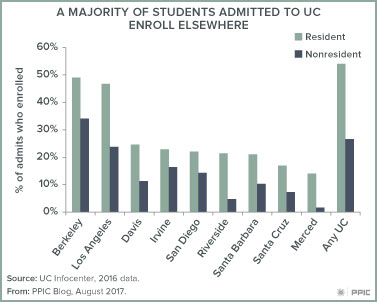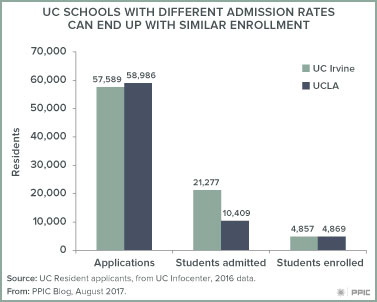The University of California’s recently released admissions data shows that about 62% of all applicants were admitted to the system for fall 2017. There are big differences among campuses: admission rates range from 16% at UCLA to 72% at UC Merced. And UC expects that less than half of admitted students will enroll.
 The proportion of admitted students who enroll is called the yield rate. The yield rate is a product many factors, including which campuses students are admitted to and whether they are California residents. UC’s systemwide yield rate was around 45% last year; at each campus, the yield rate for nonresidents (27%) is much lower than that for residents (54%). The Berkeley and LA campuses have the highest yield rates, with almost half of their admitted students enrolling. Only about one in five admitted students enroll at the other campuses.
The proportion of admitted students who enroll is called the yield rate. The yield rate is a product many factors, including which campuses students are admitted to and whether they are California residents. UC’s systemwide yield rate was around 45% last year; at each campus, the yield rate for nonresidents (27%) is much lower than that for residents (54%). The Berkeley and LA campuses have the highest yield rates, with almost half of their admitted students enrolling. Only about one in five admitted students enroll at the other campuses.
Where do students who decide not to go to the UC campus(es) that admitted them end up enrolling? UC generally faces competition from private schools in California and public and private universities in other states. Students also choose to go to a local CSU or plan to start at a community college, and low yield rates at some campuses are a byproduct of competition among UC schools. The average UC applicant for fall 2016 applied to four UC campuses, and the average admitted student was admitted to 2.3 campuses.
A UC school with higher admissions rates isn’t necessarily serving a larger number of Californians. The LA and Irvine campuses are about 50 miles away from one another and receive about the same number of resident applications. In 2016 UC Irvine admitted more than twice as many California residents (37% of applicants) as UCLA (18%). However, students admitted to UCLA are about twice as likely to enroll there, which leaves the two campuses with about the same number of entering students.

The story is similar for nonresidents. Because UC’s yield rate for nonresidents is about half the yield rate for residents, a larger share of nonresidents are admitted: in 2016, nonresidents made up 33% of admitted applicants but only 19% of enrollees.
Campuses generally have state support and classroom space for a certain number of students and use their knowledge of yield rates to reach that target. Campuses with lower yield rates make many more admission offers, and all campuses make offers to more nonresidents than they plan to enroll.
That admissions strategy can be a problem for less competitive institutions. It is impossible, after all, to know if any given student will decide to enroll, and a small change in the yield rate can have big consequences. For example, while UC Irvine’s yield rate was 23%, a small jump to 25% would have resulted in more than 400 additional enrollees. Officials at Irvine maintain that over-enrollment was not the reason for their decision last month to rescind offers of admission to about 500 students (the campus has since readmitted many of those students). However, it is easy to see how high-stakes admissions decisions based in part on predictions of applicant behavior could quickly lead to either over- or under-enrollment.
Visit the PPIC Higher Education Center


